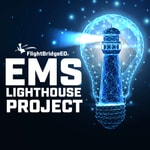The EMS Lighthouse Project – Détails, épisodes et analyse
Détails du podcast
Informations techniques et générales issues du flux RSS du podcast.

The EMS Lighthouse Project
FlightBridgeED, LLC.
Fréquence : 1 épisode/22j. Total Éps: 88

Classements récents
Dernières positions dans les classements Apple Podcasts et Spotify.
Apple Podcasts
🇬🇧 Grande Bretagne - medicine
09/09/2024#99
Spotify
Aucun classement récent disponible
Liens partagés entre épisodes et podcasts
Liens présents dans les descriptions d'épisodes et autres podcasts les utilisant également.
See allQualité et score du flux RSS
Évaluation technique de la qualité et de la structure du flux RSS.
See allScore global : 53%
Historique des publications
Répartition mensuelle des publications d'épisodes au fil des années.
Ep88 - Naloxone in Cardiac Arrest?
Épisode 88
samedi 31 août 2024 • Durée 31:48
Do you give naloxone to patients who are in cardiac arrest? Should you? Can it possibly provide any benefit at all once you are already providing effective ventilations? Well, Dr. Jarvis certainly thought not. He might have even thought it out loud. Like, loudly out loud.
Based on two recent papers looking directly at this question, perhaps he needs to eat some crow and shine the bright light of science on his own damn practice.
Citations:
1. Strong NH, Daya MR, Neth MR, Noble M, Sahni R, Jui J, Lupton JR: The association of early naloxone use with outcomes in non-shockable out-of-hospital cardiac arrest. Resuscitation. 2024;August;201:110263.
2. Dillon DG, Montoy JCC, Nishijima DK, Niederberger S, Menegazzi JJ, Lacocque J, Rodriguez RM, Wang RC: Naloxone and Patient Outcomes in Out-of-Hospital Cardiac Arrests in California. JAMA Netw Open. 2024;August 1;7(8):e2429154.
3. Niederberger SM, Crowe RP, Salcido DD, Menegazzi JJ: Sodium bicarbonate administration is associated with improved survival in asystolic and PEA Out-of-Hospital cardiac arrest. Resuscitation. doi: 10.1016/j.resuscitation.2022.11.007 (Epub ahead of print).
4. Wampler DA: Naloxone in Out-of-Hospital Cardiac Arrest—More Than
Ep87 - Those CPR Pauses, Though...
Épisode 87
lundi 12 août 2024 • Durée 27:28
Remember when we learned interruptions in compressions take a long time to recover blood pressure from? And how, to avoid these, we should do continuous compressions to avoid them. And ventilations aren’t all that important. Right? Right? Well, about that. Maybe the stories of the importance of continuous compressions were greatly exaggerated. Join Dr. Jarvis as he discusses the literature that led us to this point and some evidence that has led him to reconsider how his system approaches cardiac arrest. He’ll eventually get around to discussion a recent paper by Dr. Rose Yin that analyzes arterial pressures during cardiac arrest that was a catalyst for him to make changes in his arrest protocols.
Citations:
1. Yin RT, Berve PO, Skaalhegg T, et al. Recovery of arterial blood pressure after chest compression pauses in patients with out-of-hospital cardiac arrest. Resuscitation. 2024;201:110311. doi:10.1016/j.resuscitation.2024.110311
2. Azcarate I, Urigüen JA, Leturiondo M, et al. The Role of Chest Compressions on Ventilation during Advanced Cardiopulmonary Resuscitation. JCM. 2023;12(21):6918. doi:10.3390/jcm12216918
3. Berg RA, Sanders AB, Kern KB, et al. Adverse Hemodynamic Effects of Interrupting Chest Compressions for Rescue Breathing During Cardiopulmonary Resuscitation for Ventricular Fibrillation Cardiac Arrest. Circulation. 2001;104(20):2465-2470. doi:10.1161/hc4501.098926
4.Kern KB, Hilwig RonaldW, Berg RA, Ewy GA. Efficacy of chest compression-only BLS CPR in the presence of an occluded airway. Resuscitation. 1998;39(3):179-188. doi:10.1016/S0300-9572(98)00141-5
5. Bobrow BJ, Clark LL, Ewy GA, et al. Minimally Interrupted Cardiac Resuscitation by Emergency Medical Services for Out-of-Hospital Cardiac Arrest. JAMA. 2008;299(10):1158-1165.
6. Idris AH, Aramendi Ecenarro E, Leroux B, et al. Bag-Valve-Mask Ventilation and Survival From Out-of-Hospital Cardiac Arrest: A Multicenter Study. Circulation. 2023;148(23):1847-1856. doi:10.1161/CIRCULATIONAHA.123.065561
7. Nichol G, Leroux B, Wang H, et al. Trial of Continuous or Interrupted Chest Compressions during CPR. N Engl J Med. 2015;373(23):2203-2214. doi:10.1056/NEJMoa1509139
8. Schmicker RH, Nichol G, Kudenchuk P, et al. CPR compression strategy 30:2 is difficult to adhere to, but has better survival than continuous chest compressions when done correctly. Resuscitation. 2021;165:31-37. doi:10.1016/j.resuscitation.2021.05.027
9. Zhan L, Yang LJ, Huang Y, He Q, Liu GJ. Continuous chest compression versus interrupted chest compression for cardiopulmonary resuscitation of non-asphyxial out-of-hospital cardiac arrest. Cochrane Anaesthesia C and ECG, ed. Cochrane Database of Systematic Reviews. Published online 2017. doi:10.1002/14651858.cd010134.pub2
10. Aufderheide TP, Sigurdsson G, Pirrallo RG, et al. Hyperventilation-induced hypotension during cardiopulmonary resuscitation. Circulation. 2004;109(16):1960-1965. doi:10.1161/01.CIR.0000126594.79136.61
LHP E78 – Racial Disparities in EMS Analgesia
Épisode 78
dimanche 8 octobre 2023 • Durée 56:56
What would you say if I told you that Black patients were less likely to receive pain medication compared with white patients? My guess is you’d either question the methods, assume it isn’t possible, or ask why. Regardless of what your answer is, you’re going to want to listen to this episode. Mikey V returns to co-host a live episode from the ESO PCRF research forum, where we interview Drs. Remle Crowe and Jamie Kennel about their new research on this subject. I learned some things, and I think you will, too.
Here's a link to future ESO PCRF research forums:
https://www.eso.com/events/research-forum-pcrf/
Citation:
Crowe RP, Kennel J, Fernandez AR, Burton BA, Wang HE, Van Vleet L, Bourn SS, Myers JB: Racial, Ethnic, and Socioeconomic Disparities in Out-of-Hospital Pain Management for Patients With Long Bone Fractures. Annals of Emergency Medicine. doi: 10.1016/j.annemergmed.2023.03.035 (Epub ahead of print).
LHP E77 – Should We Reduce Sedative Dosing In RSI Of Hypotensive Patients?
Épisode 77
vendredi 8 septembre 2023 • Durée 24:46
Have you heard that you’re supposed to decrease the dose of your sedative when performing RSI on hypotensive patients? First, avoid asking why you haven’t addressed the hypotension before intubating.. maybe there’s a reason. Maybe. But, regardless of why, intubate you will. What about those doses? I’ve been hearing for years that I should be dropping the dose of sedation before RSI. But what evidence are these recommendations based on?
Today, we reviewed a paper aimed at providing some evidence on this question. Oh, and I offer a gratuitous plug for the ESO/PCRF Research Forum nerdvanna. Here’s the URL for more information:
https://www.eso.com/events/research-forum-pcrf/
Citation:
Driver BE, Trent SA, Prekker ME, Reardon RF, Brown CA: Sedative Dose for Rapid Sequence Intubation and Postintubation Hypotension: Is There an Association? Annals of Emergency Medicine. June 2023 (Epub Ahead of Print)
Also discussed:
Pappal RD, Roberts BW, Mohr NM, Ablordeppey E, Wessman BT, Drewry AM, Winkler W, Yan Y, Kollef MH, Avidan MS, et al.: The ED-AWARENESS Study: A Prospective, Observational Cohort Study of Awareness With Paralysis in Mechanically Ventilated Patients Admitted From the Emergency Department. Ann Emerg Med. 2021;77(5):532–44.
EMS LHP – E76 – One and Done Epinephrine
Épisode 76
lundi 28 août 2023 • Durée 23:49
Y’all know I have thoughts on epinephrine in cardiac arrest. Perhaps you might have heard me say epinephrine “saves the heart at the expense of the brain.” I’ve also said I don’t have an issue with any epinephrine in arrest, just how we give it currently, and have wondered if less epi might do the trick. We reviewed the One and Done paper recently published from North Carolina that looks at this question.
Citations:
1. Ashburn NP, Beaver BP, Snavely AC, Nazir N, Winslow JT, Nelson RD, Mahler SA, Stopyra JP: One and Done Epinephrine in Out-of-Hospital Cardiac Arrest? Outcomes in a Multiagency United States Study. Prehospital Emergency Care. 2022;September 26;27(6):751–7.
2. Fernando SM, Mathew R, Sadeghirad B, Rochwerg B, Hibbert B, Munshi L, Fan E, Brodie D, Di Santo P, Tran A, et al.: Epinephrine in Out-of-Hospital Cardiac Arrest. Chest. 2023;August;164(2):381–93.
LHP E75 - The Device Trial
Épisode 75
vendredi 21 juillet 2023 • Durée 39:00
We’ve spoken a lot recently about intubation First-Pass Success, including the definition. We’ve also discussed different papers about the impact the type of laryngoscope, video or direct, has on first-pass success. A new paper compares video vs. direct laryngoscopy directly. Join us to discuss the DEVICE trial.
Citations:
1) Prekker ME, Driver BE, Trent SA, et al. Video versus Direct Laryngoscopy for Tracheal Intubation of Critically Ill Adults. N Engl J Med. Published online June 16, 2023
2) Jarvis JL, McClure SF, Johns D. EMS Intubation Improves with King Vision Video Laryngoscopy. Prehosp Emerg Care. 2015
3) Ducharme S, Kramer B, Gelbart D, Colleran C, Risavi B, Carlson JN. A pilot, prospective, randomized trial of video versus direct laryngoscopy for paramedic endotracheal intubation. Resuscitation. 2017
4) Pourmand A, Terrebonne E, Gerber S, Shipley J, Tran QK. Efficacy of Video Laryngoscopy versus Direct Laryngoscopy in the Prehospital Setting: A Systematic Review and Meta-Analysis. Prehosp Disaster Med. 2023
5) Brown CA, Kaji AH, Fantegrossi A, et al. Video Laryngoscopy Compared to Augmented Direct Laryngoscopy in Adult Emergency Department Tracheal Intubations: A National Emergency Airway Registry (NEAR) Study. Acad Emerg Med. 2020
6) Hansel J, Rogers AM, Lewis SR, Cook TM, Smith AF. Videolaryngoscopy versus direct laryngoscopy for adults undergoing tracheal intubation: a Cochrane systematic review and meta-analysis update. British Journal of Anaesthesia. 2022
LHP – E74 – What Even IS First Pass Success
Épisode 74
mardi 4 juillet 2023 • Durée 21:00
What even is FPS? There's been a long-running argument about the definition of FPS. By argument, I mean mostly established in the literature, with some people not liking it. FPS is successful ET passage through the cords within 1 attempt at laryngoscopy or when the blade passes the teeth.
That definition worked well when we were using direct laryngoscopy, where the hard part of intubation was visualization and the easy part was tube passage. But does it still hold in the age of VL, where visualization is easy, and tube passage is the hard part? We discuss a paper on this episode that proposes a new definition that perhaps better meets the needs of the VL era.
Citation:
Trent SA, Driver BE, Prekker ME, et al. Defining Successful Intubation on the First Attempt Using Both Laryngoscope and Endotracheal Tube Insertions: A Secondary Analysis of Clinical Trial Data. Annals of Emergency Medicine. Published online April 2023:S0196064423002135. doi:10.1016/j.annemergmed.2023.03.021
Ep73 - Post-Mortem CT in Blunt Trauma
Épisode 73
samedi 17 juin 2023 • Durée 17:31
A new study describes the utility of post-mortem CT panscans in patients who died either in the field or in the ED to identify mortal and potentially mortal injuries. This paper has a couple of surprising findings that can help EMS focus our efforts on caring for these patients.
Citations:
1. Levin JH, Pecoraro A, Ochs V, Meagher A, Steenburg SD, Hammer PM. Characterization of fatal blunt injuries using post-mortem computed tomography. J Trauma Acute Care Surg. 2023; Publish Ahead of Print.
2. Sakles JC, Ross C, Kovacs G. Preventing unrecognized esophageal intubation in the emergency department. JACEP Open. 2023;4(3):e12951. 3. Chrimes N, Higgs A, Hagberg CA, et al. Preventing unrecognised oesophageal intubation: a consensus guideline from the Project for Universal Management of Airways and international airway societies*. Anaesthesia. 2022;77(12):1395-1415.
EMS LHP E72 - DSI vs RSI
Épisode 72
vendredi 2 juin 2023 • Durée 24:27
DSI (delayed sequence intubation) has been proposed as an alternative to RSI (rapid sequence intubation) for patients who can't tolerate interventions needed to properly pre-oxygenate patients. But does it work? There have been several observational studies (blatant bias acknowledgment: I wrote one of them!) suggesting it is safe and effective, but no randomized trials. Well, now we have one. Join Dr. Jarvis as he describes this RCT of DSI vs RSI in adult trauma patients presenting to an Indian ED.
Citation: Bandyopadhyay A, Kumar P, Jafra A, Thakur H, Yaddanapudi LN, Jain K. Peri-Intubation Hypoxia After Delayed Versus Rapid Sequence Intubation in Critically Injured Patients on Arrival to Trauma Triage: A Randomized Controlled Trial. Anesthesia & Analgesia. 2023;136(5):913-919.
Ep 71 - SGA Cage Match: Round 2
Épisode 71
lundi 1 mai 2023 • Durée 15:10
In episode 69, we interviewed Tanner Smida about his very interesting paper using the ESO dataset. It looked at the association between survival from out-of-hospital cardiac arrest and the type of SGA used (iGel vs. KingLT). He found 36% higher odds of survival with iGel.
The ink was barely dry on that paper before he published a follow-up paper looking at the same association but with a different dataset, this time CARES and the national US registry of OHCA.
Citations:
1. Smida T, Menegazzi J, Scheidler J, Martin PS, Salcido D, Bardes J. A retrospective comparison of the King Laryngeal Tube and iGel supraglottic airway devices: a study for the CARES surveillance group. Resuscitation. Published online April 2023:109812. doi:10.1016/j.resuscitation.2023.109812
2. Smida T, Menegazzi J, Crowe R, Scheidler J, Salcido D, Bardes J. A Retrospective Nationwide Comparison of the iGel and King Laryngeal Tube Supraglottic Airways for Out-of-Hospital Cardiac Arrest Resuscitation. Prehospital Emergency Care. Published online January 18, 2023:1-13. doi:10.1080/10903127.2023.2169422
